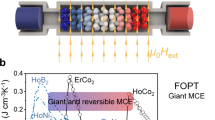Abstract
The hydrogenation reaction characteristics and the properties of its hydrides for the magnetic regenerative material HoCu2 (CeCu2-type) of a cryocooler were investigated. The XRD testing reveals that the hydrides of HoCu2 were a mixture of Cu, unknown hydride I, and unknown hydride II. Based on the PCT (pressure−concentration−temperature) curves under different reaction temperatures, the relationships among reaction temperature, equilibrium pressure, and maximum hydrogen absorption capacity were analyzed and discussed. The enthalpy change ΔH and entropy change ΔS as a result of the whole hydrogenation process were also calculated from the PCT curves. The magnetization and volumetric specific heat capacity of the hydride were also measured by SQUID magnetometer and PPMS, respectively.
Similar content being viewed by others
References
de WAELE A T A M. Finite heat-capacity effects in regenerators [J]. Cryogenics, 2012, 52: 1–7.
HASHIMOTO T, OGAWA M, LI R. Recent advance in magnetic regenerator material [J]. Cryogenics, 1990, 30: 192–198.
JIN Tao, LI Cong-hang, TANG Ke, XU Bin, CHEN Li-xin. Hydrogen absorption characteristics and structural transformations during the hydrogenation process of Er3Ni [J]. Intermetallics, 2013, 32: 162–166.
JIN Tao, LI Cong-hang, TANG Ke, CHEN Li-xin, XU Bin, CHEN Guo-bang. Hydrogenation-induced variation in crystal structure and heat capacity of magnetic regenerative material Er3Ni [J]. Cryogenics, 2011, 51: 214–217.
WANG Dong, LI Yan-li, LONG Yi, YE Rong-chang, CHANG Yong-qin, WAN Fa-rong. Hydrogen induced structural and magnetic transformations in magnetic regenerator materials ErNin (n=1, 2) and HoCu2 [J]. Journal of Magnetism and Magnetic Materials, 2007, 311: 697–701.
ZHANG Yang-huan, ZHAO Dong-liang, LI Bao-wei, MA Zhi-hong, GUO Shi-hai, WANG Xin-lin. Influence of substituting Ni with Co on hydriding and dehydriding kinetics of melt spun nanocrystalline and amorphous Mg2Ni-type alloys [J]. Journal of Central South University, 2011, 18: 303–309.
ZHANG Yang-huan, QI Yan, REN Hui-ping, MA Zhi-hong, GUO Shi-hai, ZHAO Dong-liang. Hydriding and dehydriding kinetics of nanocrystalline and amorphous Mg2Ni1-xMnx (x=0-0.4) alloys prepared by melt spinning [J]. Journal of Central South University, 2011, 18: 985–992.
WALLACE W E, MALIK S K, TAKESHITA T, SANKAR S G, GUALTIERI D M. Magnetic properties of hydrides of the rare earths and rare earth intermetallics [J]. Journal of Applied Physics, 2008, 49: 1486–1491.
LI R, OGAWA M, HASHIMOTO T. Magnetic intermetallic compounds for cryogenic regenerator [J]. Cryogenics, 1990, 30: 521–526.
LI Song-lin, LIU Yi, CUI Jian-min, YANG Wen-zhi, LI Hao-peng, HE Yi-lun. Synthesis and hydrogen desorption properties of Mg2FeH6 hydrogen storage material by reactive mechanical alloying [J]. Journal of Central South University: Science and Technology, 2008, 39(1): 1–6. (in Chinese)
HUANG Tai-zhong, WU Zhu, YU Xue-bin, CHEN Jin-zhou, XIA Bao-jia, HUANG Tie-sheng, XU Nai-xin. Hydrogen absorption–desorption behavior of zirconium-substituting Ti–Mn based hydrogen storage alloys [J]. Intermetallics, 2004, 12: 91–96.
GRATZ E, SECHOVSKY V, SIMA V, SMETANA Z, STRÖMOLSON J O. Magnetization, electrical resistivity, thermopower, and neutron diffraction in HoCu2 [J]. Physica Status Solidi (b), 1982, 111: 195–201.
ZAVALIY Y, CERNY R, VERBETSKY V N, DENYS R V, RIABOV A B. Interaction of hydrogen with RECu2 and RE(Cu, Ni)2 intermetallic compounds (RE=Y, Pr, Dy, Ho) [J]. Journal of Alloys and Compounds, 2003, 358: 146–151.
LATROCHE M. Structural and thermodynamic properties of metallic hydrides used for energy storage [J]. Journal of Physics and Chemistry of Solids, 2004, 65: 517–522.
IVES D J. Chemical Thermodynamics: With special reference to inorganic chemistry [M]. 1st ed. Wisconsin: Macdonald Technical and Scientific, 1971.
Author information
Authors and Affiliations
Corresponding author
Additional information
Foundation item: Project(51276154) supported by the National Natural Science Foundation of China; Project(2012010111014) supported by the University Doctoral Subject Special Foundation of China
Rights and permissions
About this article
Cite this article
Jin, T., Wu, Mx., Huang, Jl. et al. Hydrogenation reaction characteristics and properties of its hydrides for magnetic regenerative material HoCu2 . J. Cent. South Univ. 23, 1564–1568 (2016). https://doi.org/10.1007/s11771-016-3209-7
Received:
Accepted:
Published:
Issue Date:
DOI: https://doi.org/10.1007/s11771-016-3209-7




